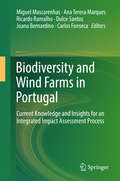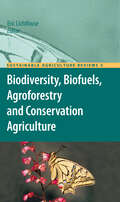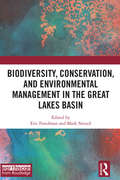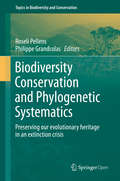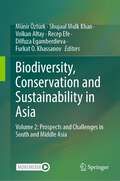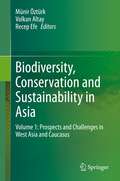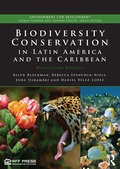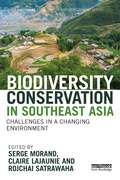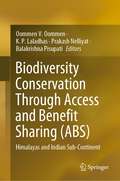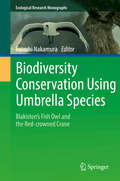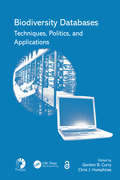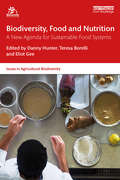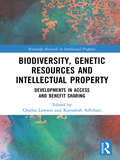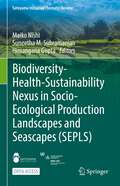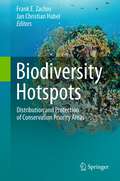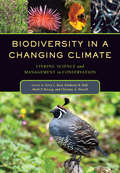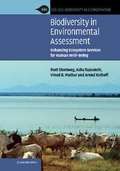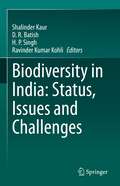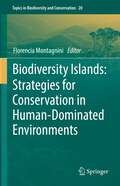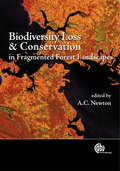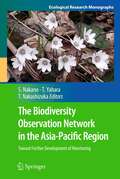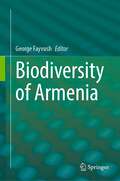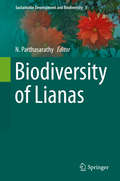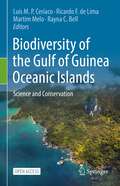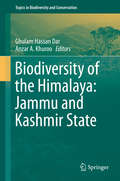- Table View
- List View
Biodiversity and Wind Farms in Portugal: Current knowledge and insights for an integrated impact assessment process
by Miguel Mascarenhas Ana Teresa Marques Ricardo Ramalho Dulce Santos Joana Bernardino Carlos FonsecaThis book presents a review of the state-of-the-art knowledge on the interactions between biodiversity and wind energy development, focused on the Portuguese reality. The volume addresses the particularities of the impact assessment procedures in Portugal, contrasting it with the international practices and presenting its main findings by covering the following broader themes: i) evaluation of spatial and temporal dynamics of wildlife affected by wind farms, including birds, bats and terrestrial mammals (in particularly Portuguese wolf population); ii) the methodologies used to assess impacts caused by this type of developments in biodiversity; iii) the best practice methodologies to implement an adaptive management approach to reconcile biodiversity and wind farms. The knowledge presented in this book was gathered through the research and development activities developed by Bioinsight company (former Bio3 company) during the last 13 years and partially funded by a R&D project designated as "Integrated solutions for biodiversity management at wind farms: reduce and compensate bird and bat mortality" (acronym: Wind & Biodiversity), co-funded by the European Regional Development Fund (FEDER), under the Regional Operational Programme of Centre (Mais Centro). This volume fills a void in the literature as a book giving insights on the best practices to install and manage a wind farm from a biodiversity management point of view, while establishing a commitment between economic sustainability and biodiversity conservation.
Biodiversity, Biofuels, Agroforestry and Conservation Agriculture (Sustainable Agriculture Reviews #5)
by Eric LichtfouseSustainable agriculture is a rapidly growing field aiming at producing food and energy in a sustainable way for our children. This discipline addresses current issues such as climate change, increasing food and fuel prices, starvation, obesity, water pollution, soil erosion, fertility loss, pest control and biodiversity depletion. Novel solutions are proposed based on integrated knowledge from agronomy, soil science, molecular biology, chemistry, toxicology, ecology, economy, philosophy and social sciences. As actual society issues are now intertwined, sustainable agriculture will bring solutions to build a safer world. This book series analyzes current agricultural issues, and proposes alternative solutions, consequently helping all scientists, decision-makers, professors, farmers and politicians wishing to build safe agriculture, energy and food systems for future generations.
Biodiversity, Conservation and Environmental Management in the Great Lakes Basin
by Eric Freedman Mark NeuzilThe Great Lakes Basin in North America holds more than 20 percent of the world's fresh water. Threats to habitats and biodiversity have economic, political, national security, and cultural implications and ramifications that cross the US-Canadian border. This multidisciplinary book presents the latest research to demonstrate the interconnected nature of the challenges facing the Basin. Chapters by U.S. and Canadian scholars and practitioners represent a wide range of natural science and social science fields, including environmental sciences, geography, political science, natural resources, mass communications, environmental history and communication, public health, and economics. The book covers threats from invasive species, industrial development, climate change, agricultural and chemical runoff, species extinction, habitat restoration, environmental disease, indigenous conservation efforts, citizen engagement, environmental regulation, and pollution.Overall the book provides political, cultural, economic, scientific, and social contexts for recognizing and addressing the environmental challenges faced by the Great Lakes Basin.
Biodiversity Conservation and Phylogenetic Systematics: Preserving our evolutionary heritage in an extinction crisis (Topics in Biodiversity and Conservation #14)
by Roseli Pellens Philippe GrandcolasThis book is about phylogenetic diversity as an approach to reduce biodiversity losses in this period of mass extinction. Chapters in the first section deal with questions such as the way we value phylogenetic diversity among other criteria for biodiversity conservation; the choice of measures; the loss of phylogenetic diversity with extinction; the importance of organisms that are deeply branched in the tree of life, and the role of relict species. The second section is composed by contributions exploring methodological aspects, such as how to deal with abundance, sampling effort, or conflicting trees in analysis of phylogenetic diversity. The last section is devoted to applications, showing how phylogenetic diversity can be integrated in systematic conservation planning, in EDGE and HEDGE evaluations. This wide coverage makes the book a reference for academics, policy makers and stakeholders dealing with biodiversity conservation.
Biodiversity, Conservation and Sustainability in Asia: Volume 2: Prospects and Challenges in South and Middle Asia
by Dilfuza Egamberdieva Münir Öztürk Recep Efe Volkan Altay Shujaul Mulk Khan Furkat O. KhassanovOf the world’s seven continents, Asia is the largest. Its physical landscapes, political units, and ethnic groups are both wide-ranging and many. Southwest, South and Middle Asia are highly populated regions which, as a whole, cover an extremely large area of varied geography. In total, this domain is unique in its plant diversity and large vegetation zones with different communities and biomes. It is rich in endemics, with specific and intraspecific diversity of fruit trees and medicinal plants, including a number of rare, high value, species. At the same time, much of the land in the region is too dry or too rugged, with many geographical extremes. Overgrazing, oil and mineral extraction, and poaching are the major threats in the area. This two-volume project focuses on the dynamic biodiversity of the region with in-depth analysis on phytosociology, plants, animals and agroecology. There are also chapters that explore new applications as well as approaches to overcome problems associated with climate change. Much of the research and analysis are presented here for the first time. We believe this work is a valuable resource for professionals and researchers working in the fields of plant diversity and vegetation, animal diversity and animal populations, and geo-diversity and sustainable land use, among others.The first volume guides our readers to West Asia and the Caucasus region, while volume two focuses on issues unique to South and Middle Asia.
Biodiversity, Conservation and Sustainability in Asia: Volume 1: Prospects and Challenges in West Asia and Caucasus
by Münir Öztürk Volkan Altay Recep EfeOf the world’s seven continents, Asia is the largest. Its physical landscapes, political units, and ethnic groups are both wide-ranging and many. Southwest, South and Middle Asia are highly populated regions which, as a whole, cover an extremely large area of varied geography. In total, this domain is unique in its plant diversity and large vegetation zones with different communities and biomes. It is rich in endemics, with specific and intraspecific diversity of fruit trees and medicinal plants, including a number of rare, high value, species. At the same time, much of the land in the region is too dry or too rugged, with many geographical extremes. Overgrazing, oil and mineral extraction, and poaching are the major threats in the area.This two-volume project focuses on the dynamic biodiversity of the region with in-depth analysis on phytosociology, plants, animals and agroecology. There are also chapters that explore new applications as well as approaches to overcome problems associated with climate change. Much of the research and analysis are presented here for the first time. We believe this work is a valuable resource for professionals and researchers working in the fields of plant diversity and vegetation, animal diversity and animal populations, and geo-diversity and sustainable land use, among others.The first volume guides our readers to West Asia and the Caucasus region, while volume two focuses on issues unique to South and Middle Asia.
Biodiversity Conservation in Latin America and the Caribbean: Prioritizing Policies (Environment for Development)
by Allen Blackman Rebecca Epanchin-Niell Juha Siikamäki Daniel Velez-LopezLatin America and the Caribbean (LAC) region is exceptionally biodiverse. It contains about half of the world’s remaining tropical forests, nearly one-fifth of its coastal habitats, and some of its most productive agricultural and marine areas. But agriculture, fishing and other human activities linked to rapid population and economic growth increasingly threaten that biodiversity. Moreover, poverty, weak regulatory capacity, and limited political will hamper conservation. Given this dilemma, it is critically important to design conservation strategies on the basis of the best available information about both biodiversity and the track records of the various policies that have been used to protect it. This rigorously researched book has three key aims. It describes the status of biodiversity in LAC, the main threats to this biodiversity, and the drivers of these threats. It identifies the main policies being used to conserve biodiversity and assesses their effectiveness and potential for further implementation. It proposes five specific lines of practical action for conserving LAC biodiversity, based on: green agriculture; strengthening terrestrial protected areas and co-management; improving environmental governance; strengthening coastal and marine resource management; and improving biodiversity data and policy evaluation.
Biodiversity Conservation in Southeast Asia: Challenges in a Changing Environment (Earthscan Conservation and Development)
by Serge Morand, Claire Lajaunie and Rojchai SatrawahaSoutheast Asia is highly diversified in terms of socio-ecosystems and biodiversity, but is undergoing dramatic environmental and social changes. These changes characterize the recent period and can be illustrated by the effects of the Green Revolution in the late 1960s and 1970s, to the globalization of trade and increasing agronomic intensification over the past decade. Biodiversity Conservation in Southeast Asia provides theoretical overviews and challenges for applied research in living resource management, conservation ecology, health ecology and conservation planning in Southeast Asia. Five key themes are addressed: origin and evolution of Southeast Asian biodiversity; challenges in conservation biology; ecosystem services and biodiversity; managing biodiversity and living resources; policy, economics and governance of biodiversity. Detailed case studies are included from Thailand and the Lower Mekong Basin, while other chapters address cross-cutting themes applicable to the whole Southeast Asia region. This is a valuable resource for academics and students in the areas of ecology, conservation, environmental policy and management, Southeast Asian studies and sustainable development.
Biodiversity Conservation Through Access and Benefit Sharing (ABS): Himalayas and Indian Sub-Continent
by K. P. Laladhas Oommen V. Oommen Prakash Nelliyat Balakrishna PisupatiThis book deals with the economic potentials of biodiversity and its capacity to support its own conservation aiming to provide livelihood for millions engaged in conservation, both now and for future generations. The book highlights the potentials of natural resources which are characterized as capital wealth (as defined in Convention on Biological Diversity (CBD)), to finance its own conservation and to provide livelihood means to people who conserve it.The book is divided into five Parts. PART I explains about the Premise of Access and Benefit Sharing (ABS), PART II describes about the Technology Transfer, PART III will provide details about the Access to Genetic Resources and to Associated Traditional Knowledge and Benefit Sharing PART IV is the Implementation of ABS Mechanisms and PART V is about ABS and Its Economics.This book will be of interest to biodiversity policy makers, administrators, university and college students, researchers, biodiversity conservationists.
Biodiversity Conservation Using Umbrella Species: Blakiston's Fish Owl And The Red-crowned Crane (Ecological Research Monographs)
by Futoshi NakamuraThis book focuses on Blakiston’s fish owl and the red-crowned crane as umbrella species. Healthy river, riparian and wetland ecosystems are necessary to maintain the populations of the two species. Both species have been revered by people since ancient times, but both are currently listed as endangered because of their small population sizes. The population decline of the two species can be mainly attributed to the degradation of the natural riparian and wetland habitats, which is associated with land use development.The populations of the two species are now recovering in Japan due to recent conservation and reproduction efforts, but the genetic diversity of the two species are still low due to previous bottleneck effects. To develop conservation and dispersal plans to establish the species over the East Asian mainland and on the island of Hokkaido, basic information, such as their regional distribution, genetic diversity, food availability, reproductive traits, and nesting, breeding, rearing, and commuting habitat, is essential. The intensive, collaborative studies conducted in Japan and Russia has clarified the status quo and the ecology of the two species. This is the first book that comprehensively compiles the above information for the mainland and island populations. In addition, it verifies their suitability as umbrella species of an ecosystem and the possibility of their future population expansion, taking into account changes in land use in Hokkaido, which is about to experience a dramatic decline in human population. As such, the book provides valuable information for students who wish to learn about these beautiful symbolic creatures, for NGOs engaged in conservation activities, and for managers who are involved in creating conservation plans and implementing restoration projects.
Biodiversity Databases: Techniques, Politics, and Applications
by Gordon B. CurryWith changes in technology and a renewed effort to catalog the world's biodiversity, huge amounts of data are being generated on biodiversity issues. As response to the call for better information systems to manage the biodiversity crisis, a wide range of solutions are being developed for inventorying, managing, and disseminating taxonomic data. This book brings together a diverse array of authors, expertise, and assessors that discuss technical developments to improve the construction, population, and dissemination of biodiversity information. It is designed to inform students and researchers of biodiversity about the changes and challenges that need to be understood by everyone in this information age.
Biodiversity, Food and Nutrition: A New Agenda for Sustainable Food Systems (Issues in Agricultural Biodiversity)
by Danny HunterThis book examines the challenges and impacts of poor diets and nutrition from current food systems and the potential contribution of biodiversity and ecosystem services in addressing these problems. There is a strong need for a multi-level, cross-sectoral approach that connects food biodiversity conservation and sustainable use to address critical problems in our current food systems, including malnutrition. Building on research from the Biodiversity for Food and Nutrition Project (BFN), which aims to better link biodiversity, diets and nutrition, the book presents a multi-country, cross-sectoral analysis of initiatives that have promoted local food biodiversity in four countries: Brazil, Kenya, Turkey and Sri Lanka. This book offers a comprehensive summary of the BFN Project results in each of the four countries along with lessons learned and how this work could be upscaled or applied in other regions. It argues that the strategic promotion and use of food biodiversity is critical in uniting attempts to address conservation, nutrition and livelihood concerns. The book is structured around chapters and case studies encompassing the BFN Project with specific experiences related by partners who played key roles in the work being done in each country. By offering a comparative view capable of furthering dialogue between the respective countries, it is also meant to connect the individual cases for a “greater than the sum of its parts” effect. This means consideration of how localized activities can be adapted to more countries and regions. Therefore, the book addresses global issues with a foot planted firmly in the grounded case study locations. This book will be of great interest to policymakers, practitioners and NGOs working on food and nutrition, as well as students and scholars of agriculture, food systems and sustainable development.
Biodiversity, Genetic Resources and Intellectual Property: Developments in Access and Benefit Sharing (Routledge Research in Intellectual Property)
by Kamalesh Adhikari Charles LawsonDebates about Access and Benefit Sharing (ABS) have moved on in recent years. An initial focus on the legal obligations established by international agreements like the United Nations Convention on Biological Diversity and the form of obligations for collecting physical biological materials have now moved to a far more complex series of disputes and challenges about the ways ABS should be implemented and enforced: repatriation of resources, technology transfer, traditional knowledge and cultural expressions; open access to information and knowledge, naming conventions, farmers’ rights, new schemes for accessing pandemic viruses and sharing DNA sequences, and so on. Unfortunately, most of this debate is now crystallised into apparently intractable discussions such as implementing the certificates of origin, recognising traditional knowledge and traditional cultural expression as a form of intellectual property, and sovereignty for Indigenous peoples. Not everything in this new marketplace of ABS has been created de novo. Like most new entrants, ABS has disrupted existing legal and governance arrangements. This collection of chapters examines what is new, what has been changed, and what might be changed in response to the growing acceptance and prevalence of ABS of genetic resources. Biodiversity, Genetic Resources and Intellectual Property: Developments in Access and Benefit Sharing of Genetic Resources addresses current issues arising from recent developments in the enduring and topical debates about managing genetic resources through the ABS regime. The book explores key historical, doctrinal, and theoretical issues in the field, at the same time developing new ideas and perspectives around ABS. It shows the latest state of knowledge and will be of interest to researchers, academics, policymakers, and students in the fields of intellectual property, governance, biodiversity and conservation, sustainable development, and agriculture.
Biodiversity-Health-Sustainability Nexus in Socio-Ecological Production Landscapes and Seascapes (Satoyama Initiative Thematic Review)
by Maiko Nishi Suneetha M. Subramanian Himangana GuptaThis is an open access book. It is a compilation of case studies that provide useful knowledge and lessons that derive from on-the-ground activities and contribute to policy recommendations, focusing on the interlinkages between biodiversity and multiple dimensions of health (e.g., physical, mental, and spiritual) in managing socio-ecological production landscapes and seascapes (SEPLS). This book provides insights on how SEPLS approaches can contribute to more sustainable management of natural resources, achieving global biodiversity and sustainable development goals, and good health for all. It is also expected to offer useful knowledge and information for an upcoming three-year thematic assessment of “the interlinkages among biodiversity, water, food, and health” (the so-called “nexus assessment”) by the Intergovernmental Science-Policy Platform on Biodiversity and Ecosystem Services (IPBES). The book begins with an introductory chapter followed by eleven case study chapters demonstrating the nexus between biodiversity, health, and sustainable development, and then a synthesis chapter clarifying the relevance of the case study findings to policy and academic discussions. It will be of interest to scholars, policymakers, and professionals in the field related to sustainable development.
Biodiversity Hotspots: Distribution and Protection of Conservation Priority Areas
by Jan Christian Habel Frank E. ZachosBiodiversity and its conservation are among the main global topics in science and politics and perhaps the major challenge for the present and coming generations. This book written by international experts from different disciplines comprises general chapters on diversity and its measurement, human impacts on biodiversity hotspots on a global scale, human diversity itself and various geographic regions exhibiting high levels of diversity. The areas covered range from genetics and taxonomy to evolutionary biology, biogeography and the social sciences. In addition to the classic hotspots in the tropics, the book also highlights various other ecosystems harbouring unique species communities including coral reefs and the Southern Ocean. The approach taken considers, but is not limited to, the original hotspot definition sensu stricto and presents a chapter introducing the 35th hotspot, the forests of East Australia. While, due to a bias in data availability, the majority of contributions on particular taxa deal with vertebrates and plants, some also deal with the less-studied invertebrates. This book will be essential reading for anyone involved with biodiversity, particularly researchers and practitioners in the fields of conservation biology, ecology and evolution.
Biodiversity in a Changing Climate
by Terry Louise Root Mark P. Herzog Christine A. Howell Kimberly R. HallOne major consequence of climate change is abrupt, dramatic changes in regional biodiversity. Even if the most optimistic scenarios for mitigating climate change transpire, the fate of many wild species rests on the shoulders of people engaged in conservation planning, management, and policy. Providing managers with the latest and most useful climate change research is critical and requires challenging the conventional divide between scientists and managers.Biodiversity in a Changing Climate promotes dialogue among scientists, decision makers, and managers who are grappling with climate-related threats to species and ecosystems in diverse forms. The book includes case studies and best practices used to address impacts related to climate change across a broad spectrum of species and habitats--from coastal krill and sea urchins to prairie grass and mountain bumblebees. Focused on California, the issues and strategies presented in this book will prove relevant to regions across the West, as well as other regions, and provide a framework for how scientists and managers in any region can bridge the communication divide to manage biodiversity in a rapidly changing world.Biodiversity and a Changing Climate will prove an indispensable guide to students, scientists, and professionals engaged in conservation and resource management.
Biodiversity in Environmental Assessment
by Roel Slootweg Asha Rajvanshi Vinod B. Mathur Arend KolhoffHuman induced development activities are introduced with insufficient attention to their consequences for our living environment, even in cases where environmental assessments have been carried out. This apparent lack of attention to biodiversity in environmental assessment is rooted in the difficulties we have in adequately addressing biodiversity within the scope, time frame and budget allocated for assessments. This book provides a conceptual background and practical approaches to overcome these difficulties. It integrates the objectives of the Convention on Biological Diversity, its ecosystem approach, and the conceptual framework of the Millennium Ecosystem Assessment into a comprehensive approach to biodiversity in environmental assessment. It highlights the need to consider the value of biodiversity based on its use by each stakeholder, addresses the importance of both social and economic development to reach the Millennium Development Goals, and provides insights into ways to balance present and future needs.
Biodiversity in India: Status, Issues and Challenges
by Shalinder Kaur D. R. Batish H. P. Singh Ravinder Kumar KohliThis contributed book is based on the current status of biodiversity in India, issues and challenges faced by the authorities involved in conservation efforts, and the imperative role of various direct and indirect stakeholders in biodiversity conservation. The book discusses the current status of different forms of biodiversity in India, challenges faced by stakeholders, issues and reasons for biodiversity losses, and efforts by government through various laws, policies, and programs in a concise and comprehensive manner throughout its many chapters. In this way, readers can access diverse information on Indian biodiversity through this book. It is compiled by leading experts in the field of conservation. In 18 chapters, it covers biodiversity of both fauna and flora, on land and in aquatic ecosystems, legal and policy aspects, as well as innovative conservation tool and techniques. It is useful for undergraduates and graduate students and also educates policy planners, bureaucrats, foresters, and researchers in India and abroad.
Biodiversity Islands: Strategies for Conservation in Human-Dominated Environments (Topics in Biodiversity and Conservation #20)
by Florencia MontagniniThis book is intended to provide an overview for the identification and establishment of biodiversity islands. It presents examples and case studies where the biodiversity islands approach is being used in a variety of locations and contexts worldwide. It will contribute to design parameters on appropriate sizing and spatial distribution of biodiversity islands in order to be effective in conservation and regeneration across the landscape, using integrated landscape management approaches. This book is essential given the current worldwide trend of habitat destruction and the need to preserve biodiversity and its values. The chapters are organized in five sections. The first section provides the introduction. Section 2,3 and 4 discuss the challenges and alternatives of establishment and management, case studies across the globe, safeguarding of the environmental, economic, and social benefits, and the final section offers a conclusion. The contributing authors present views from the academic, the practitioner and the policymaker perspectives, offering alternatives and suggestions for promoting strategies that support biodiversity conservation through intentionally designed frameworks for sustainable forest landscapes. Readers will discover suggestions and concrete examples that can be used by a variety of stakeholders in various settings throughout the world. This book is useful to researchers, farmers, foresters, landowners, land managers, city planners, and policy makers alike.
Biodiversity Loss and Conservation in Fragmented Forest Landscapes: Evidence from Tropical Montane and South Temperate Rain Forests in Latin America
by A. C. NewtonThe studies reported allow for comparative analysis across areas and help identify how human disturbance has impacted the biodiversity of all forest types. Chapters incorporate features of landscape ecology, floristic biodiversity, conservation and policy and vary from in-depth investigations of a single study area to integrated examinations across regions.
The Biodiversity Observation Network in the Asia-Pacific Region
by Shin-Ichi Nakano Tetsukazu Yahara Tohru NakashizukaBiological diversity is important for ecosystem function and services, which in turn is essential for human well-being. Under the Convention on Biological Diversity, international efforts have been made to achieve a significant reduction in the current rate of biodiversity loss. The loss continues, however. The Asia-Pacific region includes both developing countries with high biodiversity and developed countries with sophisticated data collection and analyses, but only limited information about the status quo of biodiversity in this region has been available. Many Asia-Pacific countries have rapidly grown their economies and social infrastructures, causing a loss of biodiversity and requiring an urgent mandate to achieve a balance between development and conservation in the region. In December 2009, scientists successfully organized the Asia-Pacific Biodiversity Observation Network in the region, to establish a network for research and monitoring of ecosystems and biodiversity and to build a cooperative framework. The present volume is the first collection of information on biodiversity in the Asia-Pacific and represents a quantum step forward in science that optimizes the synergy between development and biodiversity conservation.
Biodiversity of Armenia
by George FayvushArmenia is a small landlocked mountainous country located in the Southern Caucasus. It is a typical mountainous country, having its lowest point of 375m above sea level and culminating at 4095m with an average altitude of 1850m, where the landscapes and ecosystems form a complex multi-functional system. In general, the ecosystems of Armenia are characterized by a number of peculiarities, which all together contribute to formation of rich and unique biodiversity. On the small territory of Armenia (less than 30 thousand km2) there are about 3800 species of vascular plants (about a half of the whole Caucasian flora), 428 species of soil and water algae, 399 species of mosses, 4207 species of fungi, 464 species of lichens, 549 species of vertebrates and about 17200 species of invertebrates. The biodiversity of Armenia is notable for high endemism: about 500 species of fauna (about 3% of the fauna) and 147 species of flora (3.8% of total flora) are considered endemics. Such a high level of endemism is typical only for some of the large islands. Due to the huge variety of climates (from dry subtropics to cold alpine) and soil conditions all the main Caucasian ecosystems (besides humid subtropics) are represented in Armenia – deserts and semi-deserts, steppes, meadow-steppes, forests and open woodlands, sub-alpine and alpine vegetation as well as intrazonal ecosystems. Therefore Armenia is a biodiversity hotspot both within the Caucasian ecoregion and around the globe. This book compiles, summarizes and analyzes data on flora, fauna and mycobiota of Armenia, with a special focus on the impact of forecasted climate change on biodiversity and ecosystems of the region.
Biodiversity of Lianas (Sustainable Development and Biodiversity #5)
by N. ParthasarathyThis book "Biodiversity of lianas" under the series "Sustainable development and Biodiversity" is unique as it covers a wide array of topics in this subject covering all continents and will constitute a valuable reference material for students, researchers and forest managers who are concerned with biodiversity, forest ecology and sustainable development of forest resources. It contains peer-reviewed chapters from leading academicians and researchers around the world in the field of Plant Ecology, Taxonomy and related areas of Biodiversity Science but, centered on Lianology and includes original research articles, case studies and reviews (regional and global) in biodiversity, ecology and phytogeography and conservation of lianas from temperate, sub-tropical and tropical forests. The interest in lianas has increased over the last two decades. The ultimate goal of this book is to provide an insight into the patterns of liana diversity, distribution, the role of lianas in structuring forest community, and functional ecology (carbon uptake, ecosystem services, dynamics and invasion), biotechnological tool for conservation of lianas and finally summarizes the significance and the need for conservation of lianas in the changing global environmental scenario.
Biodiversity of the Gulf of Guinea Oceanic Islands: Science and Conservation
by Luis M. P. Ceríaco Ricardo F. de Lima Martim Melo Rayna C. BellThis open access book presents a comprehensive synthesis of the biodiversity of the oceanic islands of the Gulf of Guinea, a biodiversity hotspot off the west coast of Central Africa. Written by experts, the book compiles data from a plethora of sources – archives, museums, bibliography, official reports and previously unpublished data – to provide readers with the most updated information about the biological richness of these islands and the conservation issues they face. The Gulf of Guinea Oceanic Islands (Príncipe, São Tomé and Annobón and surrounding islets) present extraordinary levels of endemism across different animal, fungi and plant groups. This very high endemism likely results from the long geological history of the islands and their proximity to the diversity-rich continent. Many researchers, students and conservationists from across the globe are interested in documenting biodiversity on the islands, understanding the evolutionary origins of this diversity, and mitigating the impacts of global change on this unique archipelago. This book aims to be a primer for a broad audience seeking baseline biodiversity information and to serve as a roadmap for future research efforts aiming to fill knowledge gaps in understanding and conserving the unparalleled biodiversity of the Gulf of Guinea islands.
Biodiversity of the Himalaya: Jammu and Kashmir State (Topics in Biodiversity and Conservation #18)
by Ghulam Hassan Dar Anzar A. KhurooThe Himalaya, a global biodiversity hotspot, sustains about one-fifth of the humankind. Nestled within the north-western mountain ranges of the Himalaya, the Jammu and Kashmir (J&K) State harbours more than half of the biodiversity found in the Indian Himalaya. The wide expanse of State, spread across the subtropical Jammu, through the temperate Kashmir valley, to the cold arid Ladakh, is typical representative of the extensive elevational and topographical diversity encountered in the entire Himalaya.This book, the most comprehensive and updated synthesis ever made available on biodiversity of the J&K State, is a valuable addition to the biodiversity literature with global and regional relevance. The book, arranged into 7 parts, comprises of 42 chapters contributed by 87 researchers, each of whom is an expert in his/her own field of research. The precious baseline data contained in the book would form the foundation for assessing current status of knowledge about the bioresources, identify the knowledge gaps, and help prioritization of conservation strategies to steer the sustainable use of biodiversity in this Himalayan region. Given the breadth of topics covered under the banner of biodiversity in this book, it can surely serve as a model for documentation of biodiversity in other regions of the world. The book will be of immense value to all those who, directly or indirectly, have to deal with biodiversity, including students, teachers, researchers, naturalists, environmentalists, resource managers, planners, government agencies, NGOs and the general public at large.
